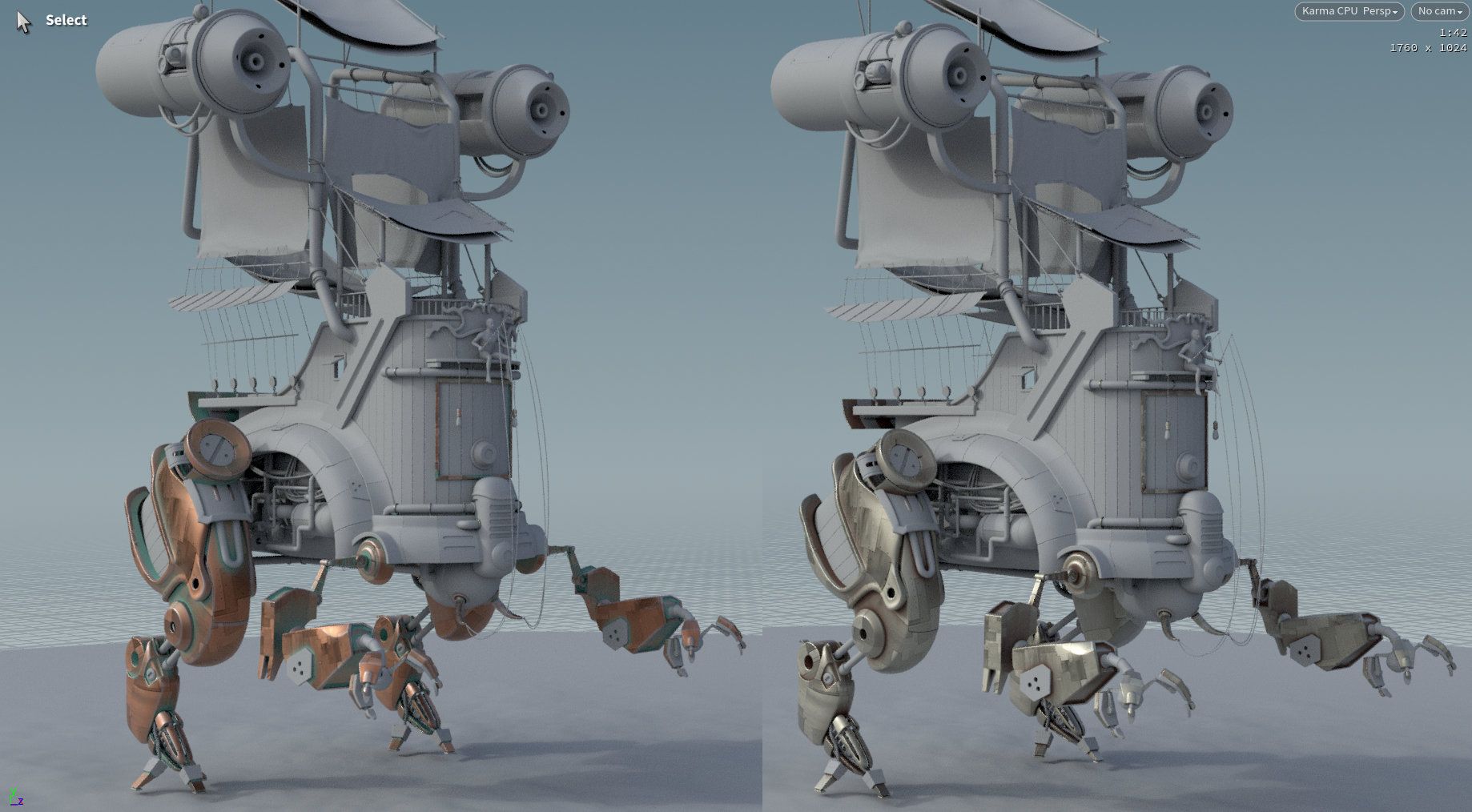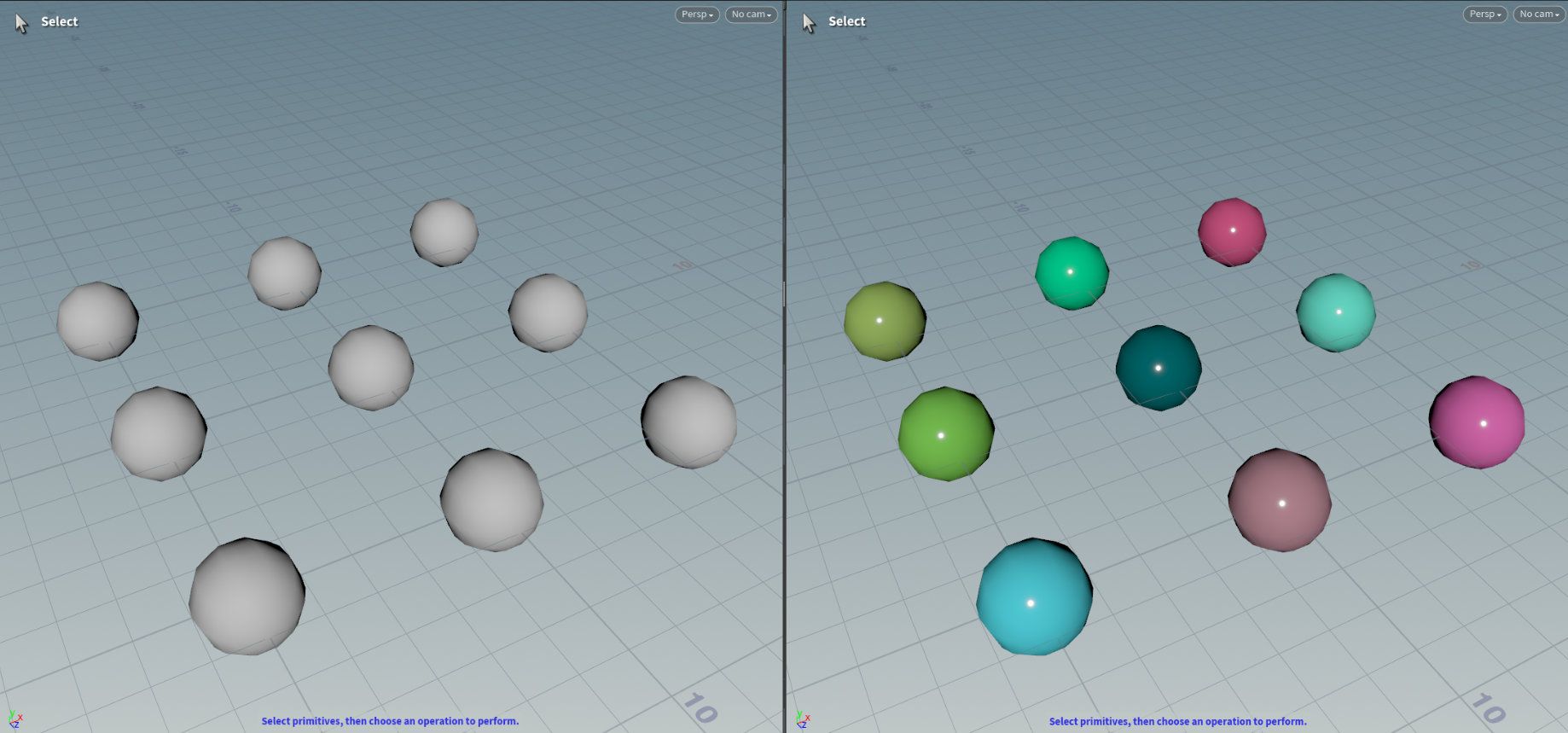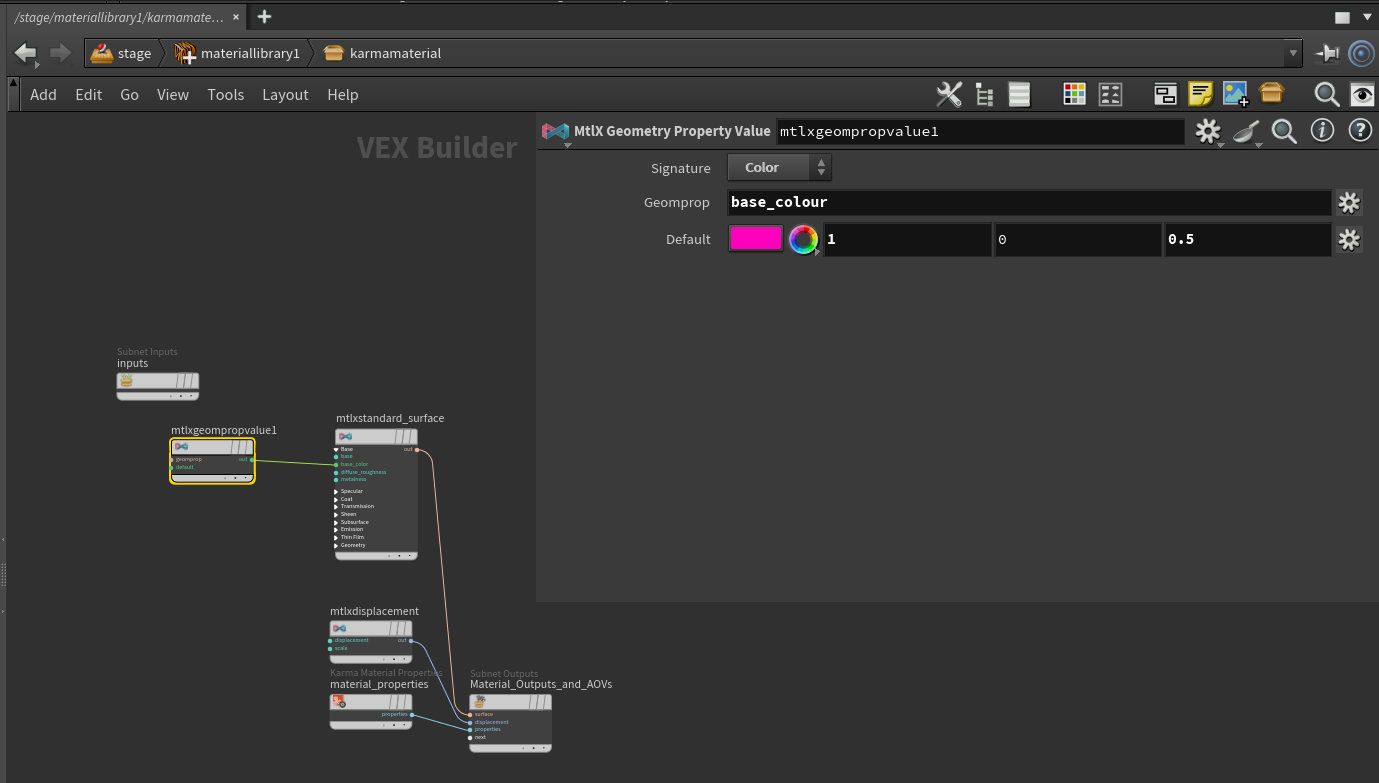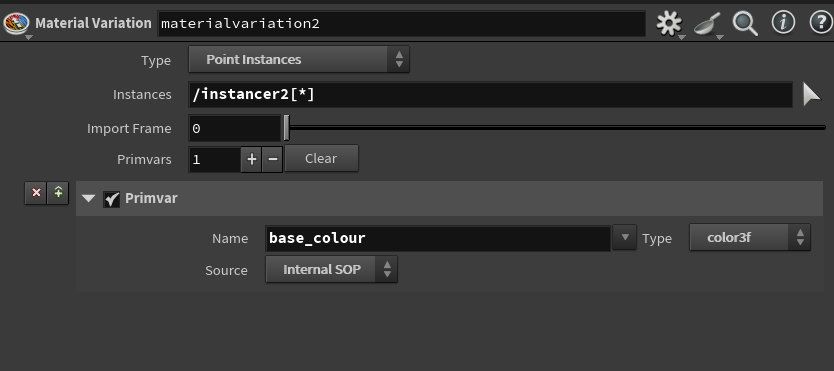

Material Variation
Visit the Node Bible
Material Variation
Houdini Docs: https://www.sidefx.com/docs/houdini/nodes/lop/materialvariation.html
This node lets you change the value of a material parameter (for example, base color) individually for each prim or point instance that has that material assigned. This node makes it easier to author material override primvars, and lets you compute the override values using expressions and/or VEX.

Visual Example of a Setup:



Syntax for Instancers:

Parameters:
Type - Whether you want to create overrides for prims (including instanceable prims) or point instances.
Primitives - The primitive(s) the node should operate on. You can drag primitives from the scene graph tree pane into this textbox to add their paths. You can also use primitive patterns for advanced matching, including matching all prims in a collection (using /path/to/prim.collection:‹name›).
Instances - A space-separated list of instances, using /‹path›[‹instance_index›] syntax (for example, /geometry/instancer[0] /geometry/instancer[1]). To select all instances in an instancer, use /‹path›[*]. To select a range, use /geometry/instancer[4-7] (the range is inclusive). To select instances inside nested instancers, use multiple indexes, for example /geometry/instancer[2][7]. VEXpressions can be used to specify instances, for example, /geometry/instancer[{@weights>0.5}].
Primvars - You can override multiple material parameters in one node. Set this to the number of overrides you want to create/edit, or click the plus and minus buttons to add or remove overrides.
Enable - For each override, whether to actually author the primvar.
Name - The name of the primvar to create or edit. Do not include the primvars: prefix. You can choose the name of a material parameter from the drop-down menu next to this field.
Type - The USD data type for the primvar, This should match the type of the material parameter. (If you choose the Name from the drop-down menu, it sets this automatically.)
Source:
-- Internal SOP - Use the SOP subnet inside this node to process points representing the prims/instances.
-- External SOP - Use an external SOP network that must generate points representing the prims/instances from scratch.
-- Uniform - Use the parameters (which can be driven by expressions).
Interpolation - When Source is set to “Uniform” and Use Snippet is enabled, the primvar interpolation authored on mesh primitives will be set to the following value and the primvar will be authored as an array attribute of the corresponding length. The interpolation of the primvar authored on instances or primitives other than meshes will always be set to “constant”.
Scalar Values - When authoring primvars on primitives or native instances with a constant interpolation, this enables the primvar to be authored as a single scale value rather than an array of length 1.
Use Snippet - When Source is “Uniform”, get the value for each primitive/instance by evaluating a VEX snippet. The snippet should write the override value to the value variable. index is the index of the current primitive/instance. You can use @Frame and @Time to make the value time-dependent.
Value - When Source is “Uniform”, the value to use for this primvar. (This can be driven by expressions.)
Featured links

About Mentorship Calls
To book a call, just visit https://www.cgforge.com/book-consultation
Study Plan Call
Look at the welcome email for further instructions on how to schedule a call if you are a Premium Subscriber.
Premium Member Discord
Unlike the standard discord server, the Premium Member server receives faster replies, feedback on projects outside CG Forge courses, and exclusive discounts on mentorship calls that aren't offered anywhere else.
Houdini Education License
In summary, the educational license of Houdini acts much like Houdini Indie - but at a discounted price. The main difference between Indie and Education is that this version of Houdini cannot be used for commercial projects. It's great, however, for learning and preparing a demo reel without the limitations of Houdini Apprentice.
Unlock Resources
One of the best examples of this is the Node Bible. This resource acts like an encyclopedia of Houdini knowledge. Each entry features a node, goes through all the parameters, and offers video quick tips on how to use each node. The Node Bible goes beyond the native Houdini documentation because it's easier to understand, offers practical examples, and links up to nodes that get used in the courses.
In the resource sections, you'll also find quick tips that cover a variety of miscellaneous topics along with The Weekly Wrangle - which is a series dedicated to advice and real-world conversations surrounding career success.
Redshift Discount
https://www.maxon.net/redshift
Aug 28th, 2024 Changelog
General Changes:
• New, simplified website design is now live!
◦ All new particle banner is featured on the home and after login pages
◦ The after-login page now features courses that are sorted by ones that you have recently watched. This makes it easier to continue watching whatever you’ve been working on without scrolling through all the courses to find what you’re looking for.
◦ There is also a new “resources” section that can be found beneath the “Browse Courses” on the after-login page. This makes it easier to bring up the Node Bible, the “Tips + Tricks,” or Weekly wrangle in a new tab
◦ “CG Forge Academy” has been replaced with a “Mentorship Calls” at the top menu (see below for more details)
◦ The resources dropdown now features “Tips + Tricks” (see below for details)
◦ Certification requirements have been slightly re-written to be easier to understand
◦ Subscriptions have been re-designed from the ground up (see below for details)
Subscription Changes:
• Subscriptions have changed to include a "Basic Subscription" and a "Premium Subscription" option. The Basic Subscription renews monthly, and the “Premium Subscription” renews every 4 months. Yearly subscriptions have been removed.
◦ These changes only affect new subscribers. Existing subscribers will not see anything change with their auto-renewal amount.
◦ 10% off a Redshift yearly subscription is now included with the Premium Subscription. (If you are currently a 4 or 12 month subscriber, then just email support@cgforge.com for this)
◦ A new “Study Plan” call has been added to the Premium Subscription. (If you are currently a 4 or 12 month subscriber, then just email support@cgforge.com for this)
◦ A Houdini education license is now available for “Premium” subscribers. (If you are currently a 4 or 12 month subscriber, then just email support@cgforge.com for this)
◦ For more information, visit the subscriptions page.
• CG Forge Academy has been redesigned to be easier to use.
◦ 45 minute calls have been removed. Existing coupons are still valid and can be used towards 90 minute sessions for the amount listed on each coupon.
◦ 8 week mentorships have been removed - Instead, you can book as many 90 minute calls as you’d like.
◦ Free onboarding calls have been removed - Instead, premium subscribers now receive a complimentary “Study Plan Call” that establishes a personalized curriculum moving forward.
◦ The “CG Forge Academy” top menu is now replaced with “Mentorship Calls” and only allows for booking 90 minute calls.
All new “Tips and Tricks” resource page:
• “Tips and Tricks” is now a resource page that holds all quick tips, Houdini update videos, and other miscellaneous videos in one place. If you’re looking for “Quicktips Season One and Two” or "Houdini 19 Updates" they have now migrated over to the “Tips and Tricks” resource section.
Discord changes:
• The CG Forge Discord channel will now be divided into two categories: “Basic Members” and “Premium Members.” The premium member channel will be invite-only to premium subscribers or those who are currently enrolled in a 4 or 12 month subscription. If you eligible to join the premium discord channel, email support@cgforge.com for an invitation.
◦ Basic Discord members will no longer receive support for projects that are outside the topic of CG Forge courses.
◦ Premium Discord members will receive support for projects outside of CG Forge content
◦ Premium members will receive discounts on mentorship calls, and basic members will not.
◦ Premium members will have their questions / posts answered before basic members
◦ Early access to courses will now be exclusively provided to premium members via the discord channel.
If you have any further questions about these changes, feel free to email support@cgforge.com
Cheers,
- Tyler
1:1 Support and Feedback
Unlock ALL Courses
Instead of paying lots of money for ONE course, you can pay less for a library of courses.
With CG Forge, you can also count on highly refined content that's conveniently found in one place. This makes it easy to cut through the clutter of Houdini tutorials out there and make the most of your time while you learn.
Disturbance
"The disturbance force introduces small amounts of change, mimicking the effects of localized environmental change. This localized change in momentum cancels itself out over time, preserving the simulation’s general motion and overall shape."
In practice, disturbance is great at capturing smaller details in a pyro sim. It's not as great at capturing larger movements and details. Artists will often use disturbance to break up mushroom shapes that occur along the leading edges of smoke simulations or to add tiny bits of detail in general.
Disturbance has two primary modes: Block-based and Continuous. Block based gives you better control over how large the detailed shapes are. The block size is represented in meters, and the larger the size, the larger size the randomized forces are on the pyro. Continuous will provide a fuzzier, smaller-detailed look, and it is often better to use when trying to soften the overall look of a pyro simulation. Continuous mode can be useful when representing avalanches or areas of mist along a waterfall.
